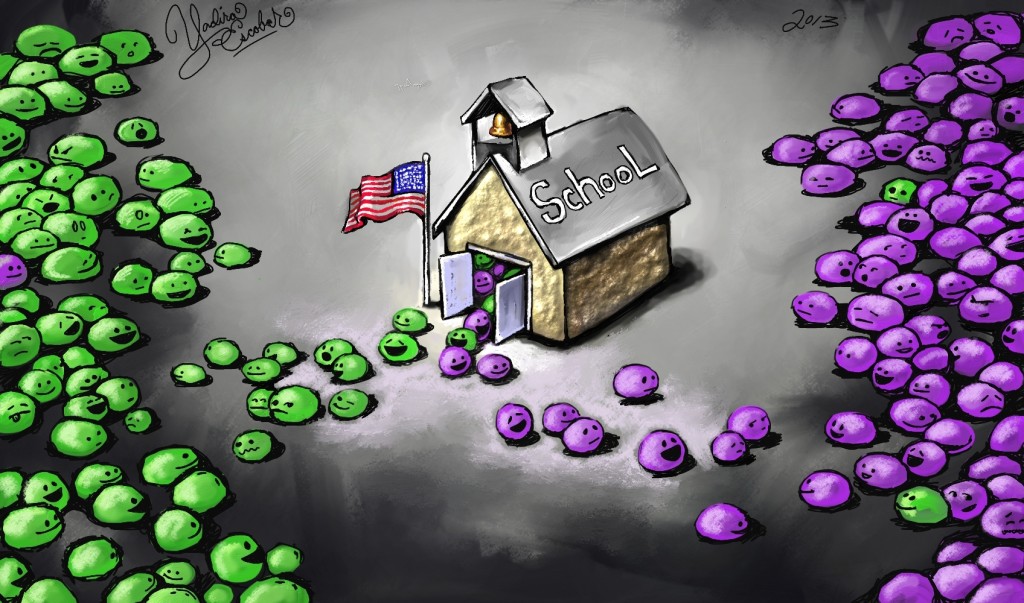
The ‘magnet schools’
MIAMI — Police sirens or occasional shootouts between youth gangs can be heard inside the music classrooms in “magnet schools,” situated in the worst neighborhoods of the big U.S. cities.
These schools receive federal funding for trips to museums or visits to art galleries, but, since their creation in the 1960s, do not seem to have achieved the integration of the most marginal nabes in U.S. society.
As early as the Kennedy administration, the federal government knew the dangers of a society divided in racial and economic regions and did what it could to reverse the process.
Magnet schools have helped some children to not limit their education to the immediate surroundings of their neighborhood. Through an enrollment system that attracts students from other barrios, especially in peripheral areas, those schools were intended to reverse the marginalization and poverty in depressed areas, so as to compensate for the “white flight” to the suburbs. In reality, the results were very different from those expected.
Lamentably, a culture of poverty is a reaction to the marginal life perpetuated by poverty and, as anthropologist Oscar Lewis pointed out in the 1960s, it promotes negative values that are contrary to the social advancement of the depressed areas.
Pessimism, day-to-day living, the bad habit of not making long-range plans, and other social pathologies have their origin in an economy of survival and improvisation maintained by many Afro-American families of a matriarchal type, where a father is absent.
The custom of some communities of creating their own self-help institutions further isolates large groups inside a cultural ghetto that is detached from the rest of society, fostering a lack of socio-political participation.
Unlike in the Latin world, suburbs in the U.S. are not marginal barrios in the periphery of cities but residential areas sought by the prosperous families as a refuge. Trailing those families are the investors and a large job market that shuns Latino immigrants, blacks and poor people in general. The latter find themselves forced to survive in low-rent ghettoes where the only lucrative enterprises are pornography or drug trafficking.
It is precisely in the midst of that urban nightmare — where education is the only hope for the new generations — that the magnet schools are situated.
In reality, the new white students rounded up in the peripheries do not incorporate into the collective environment but often bring with them racial prejudice and form exclusive groups that are even more racist. Then they return to their neighborhoods of origin without any major changes in their civic behavior.
These schools try to meet their racial quotas and specific zoning with such precision that they seem like a masterpiece of social engineering, but the results are still very poor. They remain an isolated, almost philanthropic project, lacking a vigorous redistributive policy and focused on strengthening an occupational formation and job-support programs.
Unemployment continues to be a fundamental cause of poverty and the formation of racial and cultural ghettoes that are increasingly alienated from the rest of U.S. society. Only jobs and the creation of wealth inside those zones can reverse that destructive process.
It is a mistake to waste resources trying to attract children from the suburbs, as if they were elements of superior social quality just because they come from middle classes. In reality, the origin of the inequalities between the inner city and its periphery lies in the flight of capital and job market toward the suburbs.
Common sense tells us that, instead of seeking talented children of other races in the suburbs to educate them in magnet schools, the resources should be spent educating the poor children who live in those depressed areas.
In addition, unemployed people should be given special training that would prepare them for qualified jobs. It would not be a bad idea to offer tax incentives to the companies that choose to settle in depressed areas.
Congress should protect the current antipoverty programs and not permit any cuts in the aid to the poor families whose presence is concentrated in those neighborhoods, because if poverty spreads in those barrios, sooner or later all of U.S. society will suffer the consequences.



